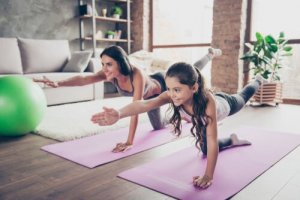The Benefits of Virtual Exercise for Children


Reviewed and approved by the psychologist Sergio De Dios González
A lot of people say that crises are also opportunities. An example of this during this global pandemic that has caused international confinement due to coronavirus is that many parents have discovered the benefits of virtual exercise for children.
We need to remember that children are in full intellectual and physical development. This means that they need space to run and discover and room to run, jump, shout, and learn from their surroundings.
However, it isn’t always possible for children to spend as much time playing outdoors as we’d like. In these situations, frustration and restlessness may manifest in children. One of the tools we have at our disposal for these times is virtual exercise.
“We are what we repeatedly do. Excellence, then, isn’t an act, but a habit.”
-Aristotle-

The advantages of virtual exercise for children
When children have to spend too much time indoors with very restricted freedom of movement, they accumulate energy that they have to release or let out in some way.
It keeps them distracted and entertained for a long time
Today, with platforms such as YouTube or Nintendo’s old Wii video game console, children can have fun exercising, moving, and enjoying the sensations their bodies produce.
Thus, use these platforms as opportunities to teach them, be with them, laugh, and, above all, spend quality time with them.
Energy expenditure
If children accumulate energy, they won’t get good sleep. Thus, they’ll feel more restless, nervous, and even irritable or grumpy.
It gives them a routine
Virtual exercise can help children establish or maintain routines, as it can become another thing for them to do during the day. Thus, your children will know that they have to exercise for a few minutes each day.
That’s why virtual exercise helps them feel more secure and stable and less irascible. It’s also a good way for them to learn that creativity can help them release energy and allow them to feel better about their bodies.
How to organize virtual exercise routines
We’ve highlighted three of the many psychological advantages of virtual exercise. On one hand, it allows you to stay fit and spend time as a family. So consequently, this improves family bonds and creates stronger ties.
How should you introduce virtual exercise into your daily schedule? Fortunately, new technology and the Internet make it very easy to do. Here are three ideal options:
- Use of home equipment. If you don’t have an Internet connection (or even if you do), you can opt for older equipment. The best one is the Wii video game console, which has several exercise games. In addition, others were developed for the PlayStation 2, 3, or 4 and the Xbox.
- Use of mobile applications. These are designed for doing virtual exercise anywhere. They’re useful, free in most cases, and share routines.
- Internet exercise. Currently, there are many channels on the Internet, mainly on platforms such as YouTube, but also on social networks and websites. On them, coaches and experts upload sessions of varying lengths and for different levels, depending on the person’s age, fitness level, gender, etc.
In addition, many of them offer live broadcasts, in case you’d like to exercise live, which adds an interesting incentive.

Physical benefits
Thanks to virtual exercise, your children will enjoy excellent physical benefits, such as:
- Better toned muscles.
- Improved speed, flexibility, and agility.
- Increased body awareness.
- Increased energy.
- Better balance.
- Breathing consistency.
- A balance between body and posture.
- A higher level of relaxation and calm.
Now that you know the benefits of virtual exercise for children, why don’t you try it out?
All cited sources were thoroughly reviewed by our team to ensure their quality, reliability, currency, and validity. The bibliography of this article was considered reliable and of academic or scientific accuracy.
Casimiro Andujar, A. J. (1999). Comparación, evolución y relación de hábitos saludables y nivel de condición física-salud en escolares, entre final de Educación Primaria (12 años) y final de Educación Secundaria Obligatoria (16 años). Tesis doctoral. Servicio de publicaciones de la Universidad de Almería: Almería.
Lacasa, P. (2011). Los videojuegos: aprender en mundos reales y virtuales. Ediciones Morata SL: San Sebastián de los Reyes.
This text is provided for informational purposes only and does not replace consultation with a professional. If in doubt, consult your specialist.








